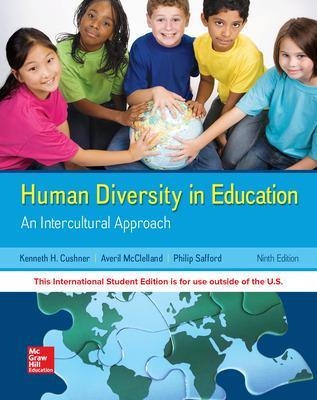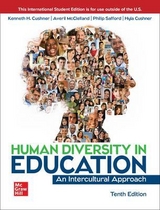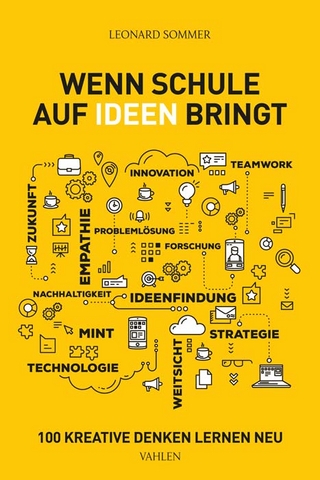
ISE Human Diversity in Education
McGraw-Hill Education (Verlag)
978-1-260-08549-5 (ISBN)
- Titel erscheint in neuer Auflage
- Artikel merken
We also maintain its research-based approach, with an increased cross-cultural and intercultural emphasis. We continue to stress that it is both at the level of the individual teacher as well as the organizational structure of the school where significant change must occur with regard to how diversity is understood and accommodated.
Instructors and students can now access their course content through the Connect digital learning platform by purchasing either standalone Connect access or a bundle of print and Connect access. McGraw-Hill Connect® is a subscription-based learning service accessible online through your personal computer or tablet. Choose this option if your instructor will require Connect to be used in the course. Your subscription to Connect includes the following:
SmartBook® - an adaptive digital version of the course textbook that personalizes your reading experience based on how well you are learning the content.
Access to your instructor’s homework assignments, quizzes, syllabus, notes, reminders, and other important files for the course.
Progress dashboards that quickly show how you are performing on your assignments and tips for improvement.
The option to purchase (for a small fee) a print version of the book. This binder-ready, loose-leaf version includes free shipping.
Kenneth Cushner is Professor of Education in the College and Graduate School of Education, Health and Human Services at Kent State University, Kent, Ohio, USA. In addition to this text, Dr. Cushner is author or editor of several books and articles in the field of intercultural education and training, including: Intercultural Student Teaching: A Bridge to Global Competence, (2007, Rowman Littlefield); Human Diversity in Action: Developing Multicultural Competencies in the Classroom, 3rd edition (2006, McGraw-Hill); International Perspectives on Intercultural Education (1998, Lawrence Erlbaum Associates); Improving Intercultural Interactions: Modules for Cross-Cultural Training Programs, volume 2 (with Richard Brislin, Sage Publications, 1997), and Intercultural Interactions: A Practical Guide, 2nd edition (with Richard Brislin, Sage Publications, 1996). A former East-West Center Scholar, he is a frequent contributor to the professional development of educators through writing, workshop presentations, and travel program development. He is a Founding Fellow and Past-President of the International Academy for Intercultural Research, and past Director of COSTthe Consortium for Overseas Student Teaching, which regularly sends students to student teach in 16 countries. In his spare time, Dr. Cushner enjoys music (percussion and guitar), photography, and travel. He has developed and led intercultural programs on all seven continents. Averil McClelland is currently Associate Professor and Coordinator of the Cultural Foundations of Education program in the College and Graduate School at Kent State University from which she received her Ph.D. Dr. McClelland has had extensive experience in curriculum design and program evaluation, as well as experience with addressing issues of gender and education and cultural diversity in education. In addition to this text, she is the author of The Education of Women in the United States: A Guide to Theory, Teaching, and Research (Garland, 1992), as well as a number of articles in scholarly journals. She received the Distinguished Teaching award from Kent State University in 1996, and has a long-standing relationship with the National First Ladies Library, where she develops web-based curricula based on the lives of the nations 44 First Ladies. Her special interests are the history, sociology, and politics of education, the reconstruction of teacher education, and internationalizing the college curriculum for pre-service and practicing teachers. Philip Safford, Adjunct Professor of Psychology at Case Western Reserve University, is Emeritus Professor and former chair of Special Education at Kent State University. Prior to earning his Ph.D. through the Combined Program in Education and Psychology at the University of Michigan, with specialization in special education and child development, he had been a teacher and administrator in residential treatment programs for children with emotional disorders. Dr. Safford has authored or edited six books and numerous articles dealing with special education history, early intervention for young children with disabilities, and related topics. He has directed or co-directed a number of training, research, and demonstration projects in special education supported by federal and state grants.
Table of Contents:
Part 1 Foundations for Teaching in an Increasingly Intercultural Context
Chapter 1 Education in a Changing Society
Case Study: Samantha Carter’s Diversity Class
The Reality of Social Change
Institutions in Transition
The Impact of Specific Changes on Basic Institutions
Rethinking Schools and Learning: The Effort to Reform Our Schools
The Difficulty of Change
Ideological Perspectives on Multicultural Education
Goals of This Book
Goal 1: To Recognize Social and Cultural Change
Goal 2: To Understand Culture, Learning, and the Culture-Learning Process
Goal 3: To Improve Intergroup and Intragroup Interactions
Goal 4: To Transmit Intercultural Understanding and Skills to Students
The Role of Stories, Cases, and Activities
Stories
Case Studies and Critical Incidents
Summary
Chapter Review
Key Terms
Reflective Questions
References
Chapter 2 Multicultural and Global Education: Historical and Curricular Perspectives
Historical Perspectives on Diversity in the United States
We Have Been Different From the Beginning
Case Study
Industrialization, Immigration, and Religious Pluralism
The Civil War: Freedmen’s Schools and the Issue of Race
Historical Perspectives on Approaches to Diversity in U.S. Schools
Anglo-Conformity and Assimilationist Ideology
Multiculturalism and Pluralist Ideology: The Civil Rights Movement and the Schools
The Emergence of Global Education in the United States
Multicultural and Global Education: Differences and Similarities
Challenges to Multicultural and Global Education in American Schools
The Difficulties of Change
Ideological Resistance to Broader Perspectives
Ideological Shifts in Governmental Politics from Liberal to Conservative
Internationalization in Higher Education
Intercultural Education and the Preparation of Teachers in Higher Education
The Impact of Global Perspectives on American Education
Summary
Chapter Review
Key Terms
Active Exercise
Reflective Questions
References
Chapter 3 Culture and the Culture-Learning Process
Exploring the Concept of Culture
Case Study: Beechland Heights: A Thought Experiment
Defining Culture
Culture in Everyday Use
Commonalities in Definitions of Culture
Humans Construct Culture
Culture Is Shared
Culture Is Both Objective and Subjective
Culture Is Nurtured
Applying the Concept of Culture
Culture-Specific Versus Culture-General Frameworks
The Culture-Learning Process
What Is Learned: The Sources of Cultural Knowledge
How Culture Is Learned: The Socializing Agents
When Culture Is Learned: The Process of Socialization
Primary Socialization and Cultural Similarities
Secondary Socialization
Some Consequences of Socialization
Perception and Categorization
Some Limits on Socialization
Understanding Cultural Differences
Variations in Cultural Environments: Returning to Beechland Heights
Variations in Cultural Attributes, Socializing Agents, and Cultural Learners
Summary
Chapter Review
Key Terms
Active Exercise
Refl ective Questions
References
Chapter 4 Classrooms and Schools as Cultural Crossroads
Case Study: Melinda’s Induction Year Dilemma
Schools and Classrooms: Where Cultures Intersect
Student Culture
Teacher Culture
Parent Culture
School Culture
Teachers as Cultural Mediators
Cross-Cultural Adaptation
Acculturation and Identity
Themes From Cross-Cultural Psychology
A Model of Intercultural Interaction
Stage 1: Understanding Emotional Responses in Intercultural Interaction
Stage 2: Understanding the Cultural Basis of Unfamiliar Behavior
Stage 3: Making Adjustments and Reshaping Cultural Identity
Applying the Culture-General Model
Identifying Commonalities Among Groups
Identifying Differences Within a Group
Critical Incidents at Wake Central High
Discussion of Critical Incidents
Summary
Chapter Review
Key Terms
Active Exercise
Reflective Questions
References
Chapter 5 Intercultural Development: Considering the Growth of Self and Others
Intercultural Competence
Case Study: Dissent at Maplewood School
Developing Intercultural Sensitivity
Ethnocentric Stages of the DMIS
Ethnorelative Stages of the DMIS
Where are You, and Most Teachers, on the Intercultural Continuum?
Critical Incidents at Maplewood
Summary
Chapter Review
Key Terms
Active Exercise
Refl ective Questions
References
Part 2 Multicultural Teaching in Action
Chapter 6 Creating Classrooms That Address Race and Ethnicity
Case Study: The Chameleon
Lay Versus Scientifi c Understanding of Race and Ethnicity
Pedagogies: Old and New
Roles: Old and New
Place of Content Knowledge: Old and New
Assessment: Old and New
Understanding Prejudice and Racism
The Functions of Prejudice
Prejudice Formation: The Components of Prejudice
How Children Learn Prejudice
Extreme Cases of Prejudice
Strategies for Prejudice Reduction
Parent and Teacher Talk
Curriculum Transformation
Improving Social Contact and Intergroup Relations 180Some Cautions in Applying the Contact Hypothesis
Increasing Cognitive Sophistication
Improving Self-Confi dence and Self-Acceptance
Increasing Empathy for and Understanding of Others
Comprehensive Programs That Improve Intergroup Relations
Antibias Education for Young Children
Cooperative Learning
A World of Difference
Facing History and Ourselves
Critical Incidents
Summary
Chapter Review
Key Terms
Active Exercise
Classroom Activities
Refl ective Questions
References
Chapter 7 The Classroom as a Global Community: Nationality and Region
Case Study: A Global Classroom
Education in a Global Society
What Is Globalization?
Characteristics of Globalization
Teaching With a Global Purpose
Education for a Global Perspective
How Do We Achieve the Cognitive Demands Required for a Global Mind-Set?
Is Technology Facilitating a Global Mind-Set?
Curriculum Transformation: The International Perspective
Perspective Consciousness
State of the Planet Awareness
Cross-Cultural Awareness
Knowledge of Global Dynamics or World Systems
Awareness of Human Choice
What, Specifi cally, Should Students Study?
Characteristics of a Global Classroom
Pedagogies: Old and New
Roles: Old and New
Place of Content Knowledge: Old and New
Assessment: Old and New span>
Teaching the Global Perspective
Comprehensive International Education Frameworks
Programs for the K–12 Context
International Baccalaureate Organization (IBO)
Asia Society/EdSteps
Programs for Teacher Education
Programs That Link Schools
Perspectives on a Globally Oriented Curriculum
Ethical Concerns
Summary
Chapter Review
Key Terms
Active Exercise
| Erscheinungsdatum | 20.09.2018 |
|---|---|
| Verlagsort | OH |
| Sprache | englisch |
| Maße | 201 x 252 mm |
| Gewicht | 712 g |
| Themenwelt | Sozialwissenschaften ► Pädagogik |
| ISBN-10 | 1-260-08549-X / 126008549X |
| ISBN-13 | 978-1-260-08549-5 / 9781260085495 |
| Zustand | Neuware |
| Haben Sie eine Frage zum Produkt? |
aus dem Bereich



